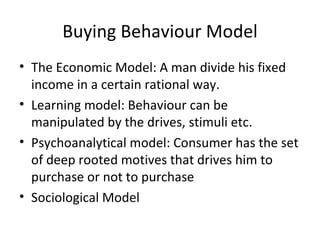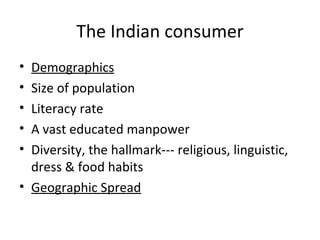Consumer buying behaviour
- 2. The most important thing is to forecast where customers are moving, and be in front of them.
- 3. Consumer Behavior Chapter 4 Version 3e Processes a consumer uses to make purchase decisions, as well as to use and dispose of purchased goods or services; also includes factors that influence purchase decisions and the product use 1
- 5. Types of buyer Individual buyer Business buyer
- 6. Influence of Social science on buyer behaviour studies Economics: Human is a rational buyer who wants to take maximum utility out of fixed/minimum price. Psychology: Acc. To psychology any human activity is directed towards meeting certain needs. ( maslow`s Need Hierarchy) Sociology & anthropology: Effect of reference group, society, role in society, etc.
- 7. Buying Behaviour Model The Economic Model: A man divide his fixed income in a certain rational way. Learning model: Behaviour can be manipulated by the drives, stimuli etc. Psychoanalytical model: Consumer has the set of deep rooted motives that drives him to purchase or not to purchase Sociological Model
- 8. Nicosia Model: This Model establish the link between consumer and the firm. --- Advertising message of the firm influence the predisposition of the consumer The consumer develops the attitude for the product Search for the information If all these activities have positive impact, purchase the product.
- 9. All the activities are divide into four basic fields: Field one—it has two subfields: Firm & consumer Advertising message by the firm Depending upon the situation consumer develops the attitude.
- 10. Field two: Search & evaluation Field three: Act of purchase Field four: use of purchase item Feedback of field is used to know the sales result
- 11. The Howard-Sheth Model Inputs in the form of stimuli Output beginning with the attention given to stimulus & ending with purchase
- 12. Factors Influencing Consumer Behavior Cultural Culture Social Reference Groups Family Roles & Status Personal Age & Life-Cycle Stage Occupation Economic Situation Lifestyle Personality & Self-Concept Psychological Motivation Perception Learning
- 13. Maslow’s Hierarchy of Needs Psychological needs (food, water, shelter) 1 Safety needs (security, protection) 2 Social needs (sense of belonging, love) 3 Esteem needs (self-esteem, recognition) 4 Self- actualization (self-development and realization) 5
- 14. Characteristics Affecting Consumer Behavior Perception is the process by which people select, organize, and interpret information to form a meaningful picture of the world from three perceptual processes Selective attention Selective distortion Selective retention Psychological Factors
- 15. Characteristics Affecting Consumer Behavior Attitudes describe a person’s relatively consistent evaluations, feelings, and tendencies toward an object or idea Psychological Factors
- 16. Buying motives Product motives (emotional & rational) Patronage motives
- 17. Buying habits Buying habits vary according to the type of goods----- Convenience goods Shopping goods Specialty goods
- 18. Buying process Problem recognition Awareness Comprehension Attitude Legitimization Trial ( depend on the product category) Adoption Post purchase behaviour
- 19. Five stage Consumer Decision-Making Process Chapter 4 Version 3e 2 Postpurchase Behavior Purchase Evaluation of Alternatives Information Search Need Recognition Cultural, Social, Individual and Psychological Factors affect all steps
- 20. High involvement & low involvement situations
- 21. Classification of Business buyers Buyers in agriculture sector Buyers in industrial sector Buyers in service sector Resellers Buyers in govt. sector Buyers in non profit business
- 22. The Buyer Decision Process for New Products Adoption process is the mental process an individual goes through from first learning about an innovation to final regular use. Stages in the process include:
- 23. Classification of consumer according to their readiness to try new products Innovators Early adopters Early majority Late majority Laggards
- 24. Business Buyer: buying patterns Goes through long negotiation Frequency of purchase Size of order Several participants in buying decision Distribution channel
- 25. Speciality due to characteristics of Market/product Buying clout Concentration of Buyer Direct, one to one Relation with buyer Technical support to buyer New product diffusion is slower Buyer may buy through intermediaries Closer monitoring of supply sources/ prices of products Derived demand More of rational buyer Business buying is partnering
- 26. The Indian consumer Demographics Size of population Literacy rate A vast educated manpower Diversity, the hallmark--- religious, linguistic, dress & food habits Geographic Spread
- 27. Favourable shift in consumption in past liberalization years According to Centre for monitoring Indian Economy : Food and beverage account for large part of consumption expenditure. But share of food has declined from 50.37(1998-99)% to 45.68( 1993-94) Share of transport and communication: 11.26---14.51 Medical and health care—3.38-4.25
- 28. Consumption of furniture and household appliances- 3.05-3.25 50 percent increase in education expenditure
- 29. Changes in life style and buying habits Ready to eat food are popular now Vacuum cleaner and cooking ranges have entered into households Shift in woman`s attitude towards cooking Yesterday`s luxuries are becoming necessities
- 30. Classification of Indian consumers based on economic status The affluent group The middle class The relatively poorer section The BPL section
- 31. The middle class explosion Size--300 million As The consumption community Not confined to big cities Constructive discontentment The phenomenon of second Voting for credit purchase
- 32. The main segment in middle class The middle class male The middle class woman The middle class teenager
- 33. The middle class male A security seeking class A blend of traditional and non-traditional Middle class male prefer ready-made Travel on increase Prestige conscious Strong family ties He is not the sole decision maker
- 34. The middle class woman Cautious, but not averse to change Quality conscious as well as cost conscious Leisure seeking Aware of new technology Good sense of grooming New self concept

































